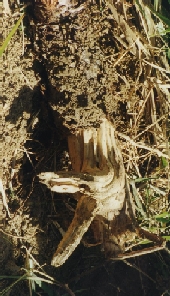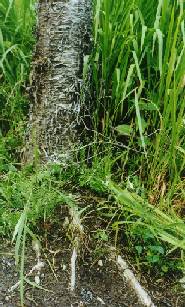General
Information about Termites (5)
Factors
encouraging Termite Attack and Control of Termites
go to main menu
Factors
encouraging Termite Attack
Conditions that put trees under stress are mostly
man-made and are the result of poor silvicultural operations.
Stress can also be caused by fire, cattle and other pests. In
general all actions that decrease the
natural resistance of the trees encourage termite attack:
- if the soil of the planting site as well as the climate
are not suitable, the trees will be weakened and become
more susceptible to termite attack in the long run
- accumulated waste wood like stumps, tree tops or branches
on and in the soil offers additional food for termites
- unsuitable nursery techniques result in low quality and
thus unhealthy seedlings that are more likely to be
attacked by termites
- improper planting favours termite attack. For instance a
coiled root will strangle itself as it grows thicker and
as a result it will start to rot and provide a potential
point of entry for termites. Upwards-bending of roots
during planting decreases the stability and health of a
tree in the long term
- damaged bark of the residual trees, caused during
tending, thinning and pruning invites termites. The
damage can be the result of falling trees, hauled logs or
skidders accidentally hitting a tree
- compacted soil and mechanically damaged rootlets caused
by skidders along log ramps and logging roads affect the
health of a tree. If the roots are damaged or not well
developed, the tree becomes sick and is then likely to be
attacked by termites




- thinning operations on steep slopes cause surface erosion
that eventually exposes the rootlets of a tree and thus
affects its health
- cattle grazing and walking in the plantation might cause
root damage and stress the tree
- the infestation of a tree by other pests can attract
termites to the already diseased tree
- any stress caused by draught, forest
fire, poorly drained soil, etc. encourages termite
attack
Control of Termites
There are several approaches to control termites,
however none of the efforts is efficient and suitable enough to
eradicate established termite colonies in a plantation. Certain
problems related to the development of chemical and biological
control strategies exist and have yet to be solved. Termites live
well hidden in the wood of a tree or in the soil and their
galleries are perfectly sealed off. Therefore it is difficult for
an insecticide or a biocontrol agent to reach the termites in
their colony. Attempts to introduce pathogens or to apply
insecticides usually fail, because the termites block off the
contaminated area of their nest. The only effective remedy to the
termite problem is to prevent termite attack. Since weakened
trees more likely to become the target of a termite attack than
healthy ones, the main goal of silviculture should be to maintain
the trees in a healthy condition. Any operations in the
plantation have to be carried out thoroughly and in such a way
that stress and the damage to residual trees are minimised as
much as possible. Preventive measures
are a long-term exercise to avoid termite attack but are not a
suitable cure for any existing termite problems. Control
strategies are:
- Biological control methods seem to be promising, but
hardly any organisms are available as suitable and
effective control agents. Natural enemies of termites
play only a minor role in termite control due to the high
number of individuals in a termite colony. Predators of
termites are mammals like echidnas or spiny ant eaters,
birds such as king fishers and rainbow lorikeets,
reptiles like geckos, and lizards, mites, spiders and
insects like assassin bugs, ants and some others.
However, termites possess a variety of very efficient
defence mechanisms that are difficult for a predator to
overcome. Ants are potential predacious biocontrol agents
but parasites or pathogens are definitely in the better
position to tackle the gigantic number of individuals in
a termite colony. There are a number of parasites and
pathogens of termites, but even these do not really
contribute much towards the natural control of termites.
Scientists from the Entomology Division of CSIRO are
testing the entomopathogenic fungus Metarhizium
for the control of termites.
- Chemical control is also not suitable in most cases since
the target is hidden in the tree and difficult for the
insecticide to reach. Previously, insecticides like Dieldrin
and benzene hexachloride (BHC) were used
for the control of termites but with little success. Now,
most of these chlorinated hydrocarbons are banned
by the international community and are not supposed to be
applied any longer. One exception is the treatment of
soil with this persistent class of insecticides in order
to control soil-borne termite pests, eg. to protect
airstrips. Other control programmes used poisonous dusts
of arsenic trioxide and arsenic pentoxide for the
treatment of termite nests, but also with little success.
Apart from the fact that the termites blocked off the
poisoned parts of their nest, these chemicals also had a
severely detrimental and often fatal impact on the tree
housing the treated colony.
- Manual measures comprise digging out subterranean nests
or removing arboreal nests and destroying the termite
queen. This is however only effective if the whole nest plus
all the individuals are destroyed. In some species
particular surviving neotenics or pseudergate soldiers
can develop into queens and re-establish the colony.
go to preventive measures
go to previous
page
go to main menu
© Michael F. Schneider,
1999

